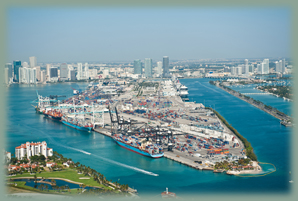
The U.S. Army Corps of Engineers, Jacksonville District completed construction on the Miami Harbor deepening and widening project. The Miami Harbor project is the first Federal navigation project in the southeast built to a 50 feet depth to accommodate today’s shipping needs.
As part of its 2012 We Can’t Wait initiative, the White House Administration announced nationally and regionally significant infrastructure projects would be expedited to help modernize and expand five major ports in the United States, including the Port of Miami. Through a progressive partnership with the State of Florida, which provided funds needed to construct the project, the timeframe for channel construction was advanced by years and took two years to complete.
Miami Harbor is the largest dredging project conducted in the region in the past decade, and is the first of its kind in the nation to combine federal, state and local funds in advance to get the project done.
The harbor construction enables the port to accommodate larger vessels, ultimately facilitating a more efficient movement of goods and services. The super-sized Panamax vessels are more than twice the size of current ships that pass through the Panama Canal and will make overseas commerce more economical and efficient. Miami Harbor is the first of four Eastern Seaboard ports to be deepened to accommodate the larger vessels. Panama Canal officials anticipate completing the canal expansion in 2016.
Miami Harbor construction brought the entrance channel depth to 52 feet, and widened the outermost portion of the entrance channel to 800 feet. The project also widened portions of the inner channel and deepened it to 50 feet. In total, five different dredges removed more than five million cubic yards of rock, limestone and sand.
“Dramatic statements were made about the effects of the dredging in Miami, specifically regarding sedimentation impacts to offshore resources. Contrary to these statements, sedimentation effects were anticipated and are expected to be of short-term duration with no long lasting effect on the ecosystem,” said Col. Jason A. Kirk, Jacksonville District commander.
Planning for the Miami project began nearly 20 years ago and involved extensive research and collaboration with local, state and federal agencies, including public input, every step along the way. “With our partners, we’ll continue to monitor the health of adjacent resources. Additional restorative and mitigative efforts will be performed should any effects prove permanent instead of short term. We remain committed to continuing our close collaboration with local, state, and federal agencies to ensure there is a proper assessment and mitigation of impacts,” Kirk said.
Already completed mitigation features of the project include the creation of 17 acres of new seagrass beds and more than 11 acres of new artificial reef with thousands of coral relocations. Long term monitoring and collaboration with environmental agencies will continue for the next several years.